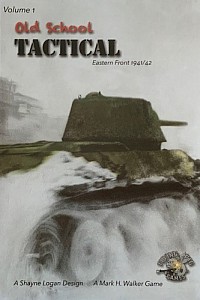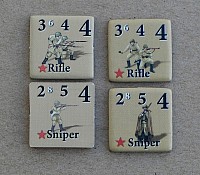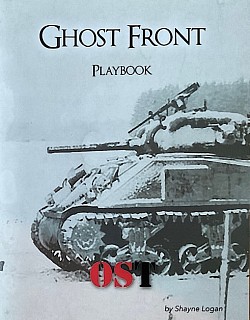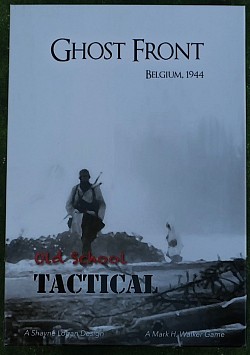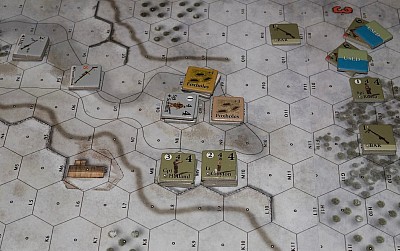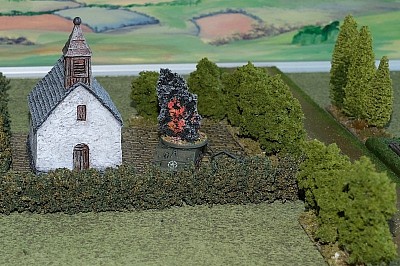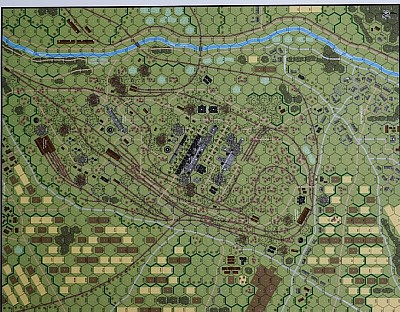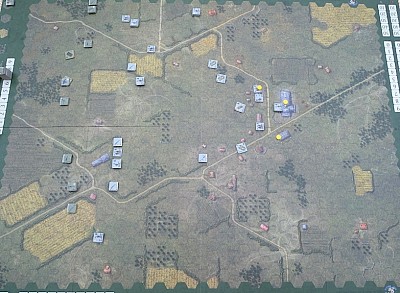Old School Tactical series
WWII tactical combat
Old School Tactical by published by Flying Pig and designed by Shayne Logan covers tactical combat at a scale of 1 hex is 50 metres and each counter is a separate vehicle, weapon team or squad.
This is the box art for the first release, which covered east front 1941 / 42. The series has become established with west front and pacific core modules and four expansions that deal with, Stalingrad, Airborne, Bulge, 9th Armored and Pacific.
The genre is potentially quite complicated, but this system has some nice depth while remaining a very playable game. It is notable for its large playing board and top notch graphics.
The upgrade kit arrives for Vol I
The Old School Tactical ‘Upgrade Kit’ for Volume I (East Front) arrived today on UK shores via Second Chance Games (UK).
My starting position is that I am a completist for this series, so while I got this, depending on one’s budget I would start by saying that it is not essential for Vol I owners, but is a nice thing to have and I am grateful to FPG to putting the effort in to getting it out and I am pleased to have bought mine.
[above image - old counters on the left, new to the right].
For those owning Vol I, the situation we are in came from the initial growing pains of the series. The core Vol I set was initially bundled with the Stalingrad module, which was a stretch goal on Kickstarter.
This was fine at the time, but had a built in problem. In some areas the Core Volume I set and the Stalingrad module became a little integrated in fringe parts. Some of the scenarios need counters that were in the Stalingrad module and one scenario needed both some counters and the Stalingrad board.
This only really became an issue when Vol I sold out and Flying Pig reprinted the Core Volume I as a straight reprint in a stand alone form, without the Stalingrad module. Obviously vol I was now making references to game parts only found in the Stalingrad module, which was well out of print.
The cry went up that customers had bought a reprint, which had a couple of scenarios in it that could not be played and as a consequence, Flying Pig Games came to the rescue with a reprint of the Stalingrad module.
The situation I am in is that I have Vol I and a nicely boxed reprint of the Stalingrad module and it is being in this situation that makes the purchase of the upgrade kit a considered option. I f you only have volume I, but not the much sought after Stalingrad module, then I think your compulsion or benefit to upgrade might be higher than mine.
Anyway, what does the upgrade mean to me?
Updated Quick Reference Sheet - not long after publication, the Vehicle Combat Result table was tweaked slightly to make anti-tank fire a bit more deadly ….. and a ‘bit’ is all it is, but it took the results in a direction asked for by the fan base. I have always used the charts from Volume II (NW Europe), which had the updated table and Flying Pig Games did make it available as a download option for Volume I owners, but now with the upgrade. Vol 1 has its own corrected sheet (a pair of them) and these are on heavier stock than the original ones in Vol 1.
Updated T34/85 data card - A few years ago, I posted an article about OST gun performance and wondered why the Soviet 85mm was not performing as well as might be expected. The Upgrade kit gives us a new T34/85 data card that better (in my view) represents the anti-tank penetration values of the 85mm, which has been tweaked so that the gun sits in a better relationship between the German 75/48 and the German 88/56 tank guns. For anyonw wanting to see my original article, here is the link
https://battlefieldswarriors.blogspot.com/2019/02/old-school...
Updated Scenario book - the physical presentation of the scenarios has been changed to match all of the scenario books (Playbooks) that followed and some scenario errata has been sorted out. The ‘Cornered Cats’ scenario has been removed, this is the one that required the Stalingrad gameboard and the T34/85’s and they have added two new scenarios.
These are described as ‘Starter Scenarios’ and each is a 4 turn action, with a nice small order of battle. They look like they will do the job intended for them, while also giving the regular player a mid-week opportunity to roll some dice or even act as a refresher if they have spent a bit of time away from the system. All tactical warfare games have the potential to be complicated for the first dive in, though I feel in general, OST is the best tactical game at getting a good balance between playability / feel and simulation - obviously a personal view.
I have cut the ‘Cornered Cats’ scenario from my original playbook, laminated it and added it the new upgraded playbook, simply because I have the Stalingrad board.
Updated rules - the latest Version 5.65 is included. This is a small update to the recent V5.6 and notably has the new replacement Machine Gun ‘Sustained Fire’ rule in it. When I say small, I mean small compared to the rule sets that we have been using with Volumes II and III (Pacific), but as a replacement for the original rulebook in the earlier Volume I’s, it is a respectable upgrade, if only because it is better organised and easier to find your way around it.
Data Cards and Luck cards - These have all been replaced with cards that hold the same information, but they are slightly sturdier and have a sort of parchment texture on them. As mentioned, the T34/85 card has been amended, other than that they seem a straight replacement except that there are 9 additional Luck Cards, which have been nicely thought out and are most welcome.
Counters - all of the counters have replacements (well sort of). You get four frames and they have the new style of art (not hugely different from the old, but for example the sniper is laying down rather than standing up and the figures overall have more detail / better definition). My old counters are still looking good, but what is useful to me is the extra admin markers that you get, especially the Fired / Moved / Used counters. I have replaced all of my combat counters for the upgraded ones, but for the admin counters, I have simply added the new to the old, to create a bigger pool.
When I say ‘sort of’, the exact composition of the frames have been jiggled a bit, so for example the Germans have one Captain less and one sniper less, but the Pioneer counters have been increased from four to six.
I have kept all of the old stuff bagged up to one side for emergency spares. An upgrade kit gives an excellent opportunity to replace worn counters, though I must say, my originals are looking excellent, which speaks volumes of the quality of these pieces (plus I take good care of my games ….. no eating crisps and such like at my table!)
Finally, attached in a little baggie at the back of the kit were 4 or 5 Soviet support weapons. My understanding is that these were missing from the 2nd Edition print run and have since been produced and made available and so they are also included here.
So, bottom line, this is a nice rather than essential purchase to the series. If you have Vol 1 but not the Stalingrad module, it may move higher up your ‘needs’ list. I’m glad I bought mine, there is enough here for me to see the benefit. I like having the latest rulebook in proper form, the updated T34/85 card, the 9 new luck cards, the reformatted scenario book with two new additions and it’s also nice to end up with plenty of moved / fire / used markers. The rest is eye candy, which as a regular player, I also appreciate.
Thanks to Shayne Logan for working tirelessly to expand this system and being on hand here to answer questions and to Mark at Flying Pig Games for having committed the company to getting a good quality product out and for standing behind
New module for east front
The latest release covers Operation Bagration - 1944. As a package, this is a step up from the previous module ‘Phantom Division’ as we get an extra map, but of real note is an additional 4 part scenario - a `big’ battle.
The extra scenario is played out on one of the big boards from OST Vol 1 (East Front core game) and basically the surviving units from the current game stay on the map and the next scenario introduces reinforcements.
There is an additional twist - with the victory points earned in each scenario, you can buy some bonus reinforcements from a pool. This looks a great way to use one of the big boards to its most potential.
There is a write up over on the blog that looks at the components and the scenarios. LINK.
http://battlefieldswarriors.blogspot.com/2023/02/red-blitz-new-ost-module.html
Any Day: The Ruhr pocket
This is the final scenario in the Old School Tactical ‘Phantom Division’ module, set in April 1945. It has been well thought out, with the German defenders being a ramshackle mix of units brought together, brittle but well armed, making them a potential tough obstacle and a situation that makes one think of the sad souls who lost their lives, seemingly needlessly, in the closing weeks of the war.
This is a one mapper, playing in just 7 turns, so is a good fit for a short evening of face to face gaming.
The Germans have a mix of morale levels, but an interesting touch is that for every 5 casualty points they suffer, the German morale levels across the board get worse by one point, plus a leader must actually be present with a unit for it to stand a chance of rally during the impulse phase. Collectively, this does a really good job at reflecting the brittle nature of the defence.
To win, the Americans must cause all the German forces to have a worse status than ‘good order’ or occupy 5 of the 7 objective buildings. This is an excellent map, reminiscent of the old Board 1 in the basic Squad Leader game (Avalon Hill) in 1978.
In this photo, our opening impulses brought some exciting tension as the Tiger and lead Pershing opened up in a close-up gun duel, with several shots missing and setting a narrative of crews under so much pressure to hit rather than being hit themselves, that they ‘fumble’ through the anxious moments, with a mix of panic, excitement and anxiety all plating their part. Even a Panzerfaust armed infantry section tried to get in on the action!
Phantom Division Scenario 2
Elcherath 18th December 1944 - Scenario 2 from the Phantom Division module.
Near St. Vith, the Americans are counter-attacking to recapture the village of Elcherath and nearby high ground.
This photo shows the part of the attack against one of the ridge positions at the top of the map. This is a two mapper scenario in the pocket battles format.
To get this far, the Americans have taken heavy infantry casualties to Sergeant Russo’s 1st Platoon, so 2nd platoon under Captain Holland and Lieutenant Clayton have paused in a blind spot just under the ridge, while two Sherman tanks (under the blue used counters) move up to support the final push onto the end of the ridge.
In total there are 5 objective hexes between this part of the map and further south. To win, the Americans must capture 4 of them in 7 turns, which is a tight schedule.
At the end of turn 7, the system requires a roll to see whether the scenario is extended by a further turn. Here it is and the Americans manage to capture 2 more objectives to give them the win.
The arrival of the Sherman reinforcement is important as it helps maintain the momentum of attack, plus, in the final moments, they may be able to manoeuvre onto any undefended objective hexes …. though the German defence bristles with panzerfaust and panzerschreck anti tank weapons.
Using OST rules with figures
Running a trial on my Pinboard Wars table, I had a go at using the OST rules with 1/144 scale vehicles. The conversion is testing 1 hex equalling 1 inch on the table.
The Germans had two Panthers, while the Americans had two 75mm armed Shermans and a 76mm armed Sherman.
On the opening turn, the Germans rolled very badly for their Impulse Points, however, they did win the initiative so got to fire first. This fire was made against the 76mm armed vehicle.
The Sherman Brews!
Attacking with a gun value of 13 against an armour defence of 5 (+1 for the cover of the hedge), there was every chance that if hit, the Sherman was going to be knocked out …. And it was!
In turn two, the Americans rolled really poorly for their Impulse points, denying them the chance to reverse out of trouble before the Panthers did what panthers do!
The Shermans in the cornfield managed to hit one of the Panthers and cause it to go ‘Shaken’, but the remaining Panther got lucky and hit both Shermans, destroying them both.
It seems to work
The conversion is quite simple, but it played with exactly the same feel as the boardgame. I now just need to bring infantry into the fray and try out the artillery rules to see how well it all works together.
To represent stacking, I will simply allow units touching count as being stacked.
At this scale, converting 1 hex to 1” seems to look and feel right.
EDIT - I have put a bit more detail up on BoardGameGeek, which shows the various stages of action. LINK
https://boardgamegeek.com/thread/2846090/article/39838112#39838112
OST meets ASL
You might think this map looks very ASL like and you would be right. This is the map taken from the ‘Steelworks’ module by 3rd Party ASL producers Lone Canuck Publishing.
The subject is very interesting, so I have been looking at playing the scenarios using the ASL map, but with OST counters and rules. So far, I have just done the smallest scenario and it gave a very good game.
I have put notes, ideas and an AAR up over on the blog. LINK
https://battlefieldswarriors.blogspot.com/2021/08/the-steelworks-asl-meets-ost.html
The Stalingrad board
Today I played the ‘Siberians’ scenario from the Stalingrad module. The blurb says;
23rd September 1942. ‘The 13th Guards Division was reaching its breaking point.
In the early morning hours, elements of the 284th Rifle Division were ferried across the Volga to join the fight. the rugged Siberians of the ‘Tomsk’ Division were feared by the Germans.
These hunters and frontiersmen would push back the enemy and buy the 62nd Army some time. From the beaches, Col. Batyuk’s men plough into the city’.
Playing the full board
The system has a few full board scenarios. This once comes from the Phantom Division module.
The Americans start by attacking from the left, but their attack is under-powered. Mid-game, they get reinforcements of tanks, engineers and assault teams …. But is it all too little too late? it felt so in my game.
The Americans really need to break into the board to capture the concentration of large buildings on the right, but here, the reinforcement got snarled up amongst the farm on the bottom left of the map and horrendous casualties, together with a ticking clock saw the entire attack stall.
